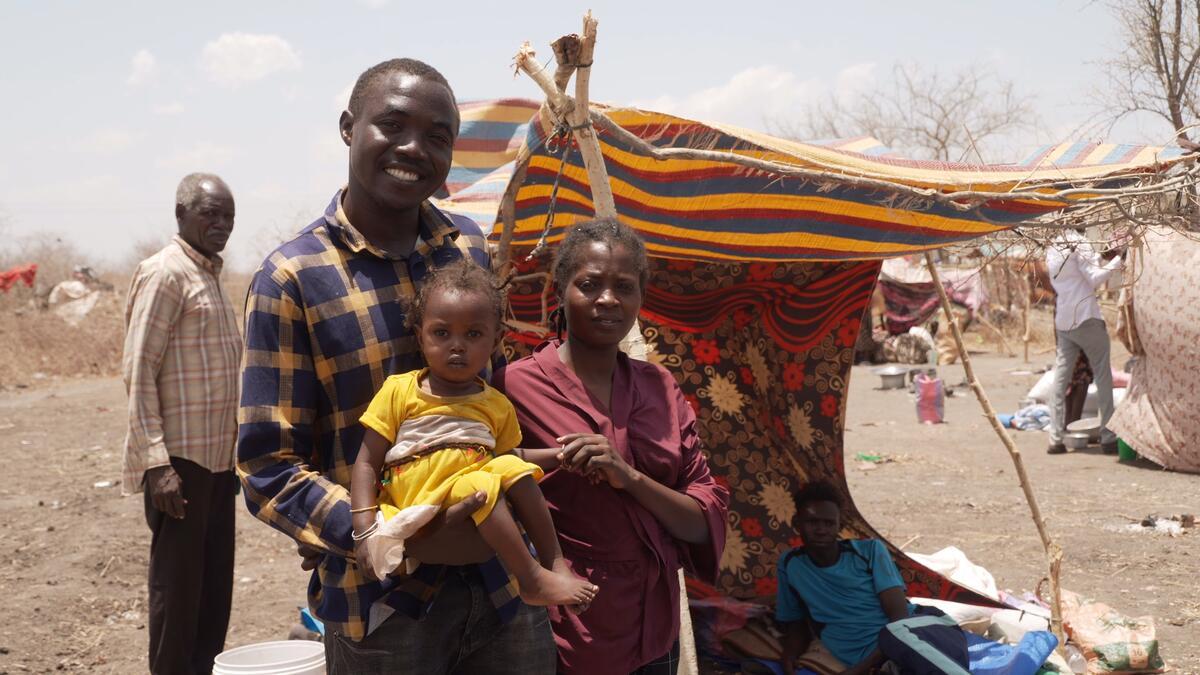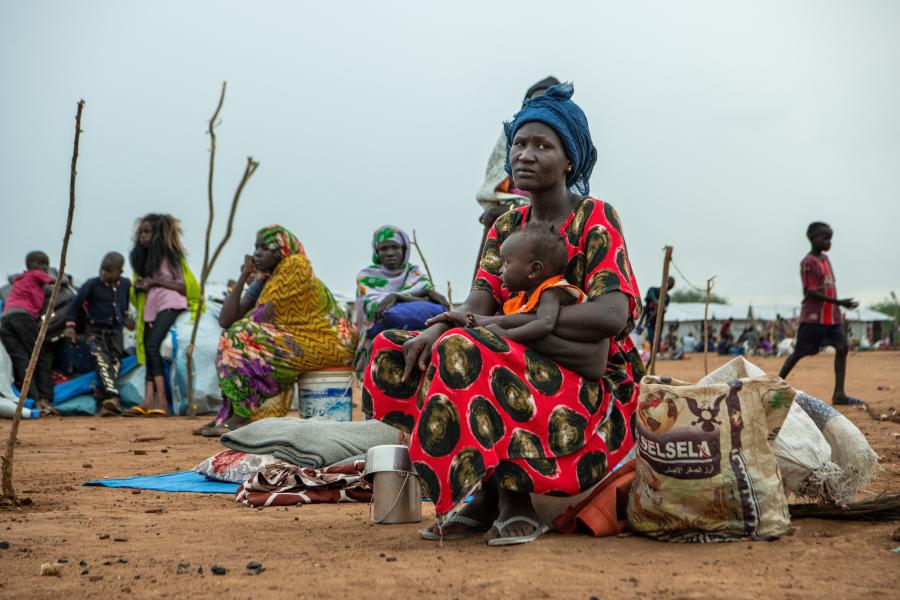2023 situation overview
The South Sudan crisis has been fuelled by intercommunal violence, compounded by climate change and food insecurity; displacement numbers have remained high for South Sudanese refugees. Four consecutive years of flooding have destroyed homes and livelihoods, exacerbated food shortages and weakened the economy. The majority of South Sudanese refugees have been in asylum for over a decade. Others have been born in exile, evidence of the deep-rooted and long-standing nature of the crisis and resulting displacement.
The displacement crisis remained one of Africa's most significant at the end of 2023, with over 2.2 million refugees spread across the neighbouring countries of the Democratic Republic of the Congo (DRC), Ethiopia, Kenya, Sudan and Uganda. Another 2.2 million South Sudanese were internally displaced. By the end of 2023, Uganda hosted 41% of the South Sudanese refugees in the region, Sudan hosted 30%, Ethiopia hosted 18.5%, Kenya 8%, and the DRC 2.5%.
At the end of 2023, 58% of South Sudanese refugees in the region were children. Their vulnerability and specific needs required targeted humanitarian assistance and protection measures. 34% of the total population were youth and adolescents, highlighting the urgent need for secondary and tertiary education and other programming for this target group. Women and girls, 52% of the refugee population, were exposed to particular risks, including violence, due to prolonged displacement amidst resource scarcity. They needed targeted support related to child protection, the needs of adolescents and youths, gender-based violence, and gender equality.
An increase in new arrivals of refugees from South Sudan alongside other nationalities in 2022 and 2023 further strained services for refugees in asylum countries. For example, Uganda received over 55,000 refugees from the DRC, Eritrea and Sudan in 2023. While host countries have moved toward greater integration into national systems and emphasis on improving livelihoods and self-reliance, these efforts remained a work in progress as the countries of asylum faced their own development and security challenges.
The outbreak of conflict in Sudan in April 2023 resulted in the displacement of Sudanese nationals and South Sudanese refugees, especially those in Khartoum. South Sudanese refugees fled within Sudan and relatively safe areas saw a rapid population growth, most notably the White Nile camps, where an estimated 145,200 South Sudanese refugees arrived in 2023.
South Sudanese in Sudan suffered from the breakdown of social safety nets, various forms of community support, and family separation. The situation was particularly dire for refugee children, with alarming malnutrition rates indicated by the standardised expanded nutrition survey and mid-upper arm circumference data in 2023. The situation deteriorated in the White Nile refugee camps between May and September due to disease outbreaks, and the population suffered over 1,200 child deaths related to communicable diseases, malnutrition and other causes. With the populations being dependent on irregular and scarce food assistance, harmful coping strategies often generated protection risks, including child labour and the sale and exchange of sex.
The crisis in Sudan prompted more refugees to return to South Sudan in 2023 than in the previous two years together. 525,400 returned in total in 2021 and 2022, but in 2023, 527,200 spontaneous returns were recorded, mainly from Sudan (399,000) with a spike from April 2023 due to the crisis. In December, there were 53,400 returns despite adverse conditions in South Sudan. Prior to the 2023 conflict, Sudan was home to more than 800,000 South Sudanese refugees.
In Ethiopia, 9,800 South Sudanese families (7,100 refugee and 2,700 host community families) received livelihood support from UNHCR. This represented only 5% of the working-age refugee population. More than 600 refugees and 2,000 host community members received agriculture and livestock distributions and training. Over 330 hectares of land were put under crop production. The Refugee and Returnees Services issued over 3,700 work permits for employed refugees and more than 2,700 residence permits for refugees engaged in joint projects with host communities.
In Kenya, integration into national systems and access to services such as health care and education progressed, particularly within the framework of the Government’s ‘Shirika Plan’. This new approach to refugee management announced by the Government of Kenya aimed at transforming the refugee camps into integrated settlements supporting the socioeconomic inclusion of refugees and hosting communities in Garissa and Turkana counties and urban areas. However, challenges remained, particularly regarding the full inclusion of refugees in national social protection, education, and livelihoods programmes. In Kenya, $1.05 million was disbursed as cash assistance to support 225,500 individuals with energy costs, hygiene, shelter, voluntary repatriation and education.
In Uganda, the Government continued to implement progressive refugee policies, allowing South Sudanese refugees access to land and basic services. But a lack of funding meant that UNHCR was not able to maximize the impact on refugees. For example, there was a gap in the procurement of materials for primary and secondary schools for the last two terms in 2023, and nearly 400,000 students went without educational materials.
Regional efforts to address the South Sudan displacement crisis involved the Intergovernmental Authority on Development (IGAD) and the East African Community (EAC), which advocated for the integration of refugees into national systems and for exploring regional solutions. A joint initiative by IGAD and EAC produced a landmark Ministerial Declaration in favour of solutions for refugees within the East and Horn of Africa region.
The South Sudan RRRP was only 18% funded by the end of 2023, indicative of the low resourcing and limited capacity of the refugee response at current funding levels. The DRC, Ethiopia and Uganda were among UNHCR's 13 most underfunded operations in 2023.
With less funding and a larger population of refugees, the RRRP’s partners in the WASH, shelter, settlement and housing sectors struggled to meet standards of assistance for refugees, although their services required expansion and maintenance to prevent disease outbreaks.
Refugees’ continued dependency on firewood for cooking, a result of the underfunding of environmental goals, obliged women and girls to forage further and further from the settlements, exposing them to physical protection risks. South Sudanese refugees were also affected by reductions in food assistance in Kenya and Uganda and by a pause of WFP’s food distribution from June to October 2023 in Ethiopia.
Underfunding translated into protection and health risks, sexual exploitation, and child labour. Reduced investments in water systems disproportionately affected girls, who ended up missing school in order to fetch water. For Kenya, reduced funding significantly affected all programmes, but the most affected were shelter, WASH, food and protection (including child protection and gender-based violence services).
In Sudan’s White Nile area, refugees’ needs remained chronically underfunded and under-served, with only a small presence of humanitarian actors. With the large-scale movements of South Sudanese and other refugees out of Khartoum to White Nile, all services were stretched beyond capacity and there were only a limited number of humanitarian organizations on the ground.
Financial overview
More contributions information on previous years: Funding Update 2022 | Funding Update 2021
Sudanese refugees fleeing conflict find safety in South Sudan
By Melik Benkritly and Moulid Hujale in Renk, South Sudan
After three days in a transit centre in Renk County, in South Sudan’s Upper Nile State, Ousman Abdallah and his family are finally boarding a bus to Doro refugee camp in Maban County. They are among many other thousands of Sudanese refugees who have crossed the border to seek safety in South Sudan since the fighting erupted in mid-April.
Read the story

